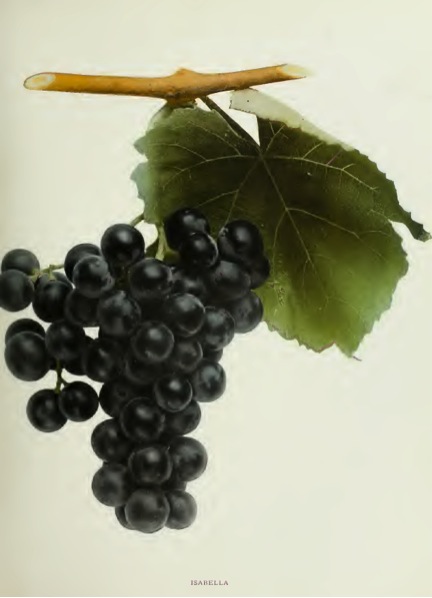 ISABELLA
ISABELLA
Coming into general notice in America during the second decade of the nineteenth century, this natural cross between a Native Vitis labrusca and some European import (various commentators have proposed the Munier, the Burgundy, and Catalan) quickly became a standard wine grape in the country. Because its quality was generally admitted, and because the horticulture of the period did not have a reliable matrix of grape traits that could distinguish Native from European grapes, the agricultural journals of the United States ran dozens of stories puzzling over the origins of the grapes. Certain elements of the story remained constant (1) that the grape was named for Isabella Gibbes, spouse of George Gibbs (2) that the original vine came from somewhere in the Carolinas and was brought to New York, and (3) that William Prince, the elder, secured cuttings and distributed it through the nation's networks of fruit growers. Prince in 1828 published a narrative of the grape's origins, tracing an itinerary from Goose Creek, SC, to Cape Fear, NC, to Brooklyn, NY, and finally to his Linnaean Garden. Its details would be interrogated for the next four decades by a dozen writers with a doggedness unequalled in the commentary on any other grape. The passion attests to its high place in the esteem of Americans. Because of its resistance to Phylloxera and Pierce's disease, its ability to tolerate both hot and cold, and its vigorous productivity, the Isabella was planted throughout the world, being used as a wine grape in Brazil, the Ukraine, and Italy. The most reputable of these wines is the strawberry scented Fragolino Rosso of Italy.
The Isabella spread with rapidity throughout the settled portions of the United States. While an excellent table grape, the Isabella seemed to its earliest American cultivators, an ideal wine grape for making a robust red. Alden Spooner of Brooklyn, NY, was issuing wine from his plantings in 1832. ["Isabella Wine Grape," Genessee Farmer (Nov. 24, 1832), 374.]
"Bunches loose, shouldered; berries oval. Dark Purple, nearly black when fully ripe, and covered with a blue-black bloom. Flesh juicy, with a rich, musky aroma; tough pulp, and a great deal of acidity. Ripens irregularly." [Descriptive Catalogue of American Grapes (Bushbergy, MO, 1895), 141.]
Image: Hedrick: Wines of New York (1913).
David S. Shields